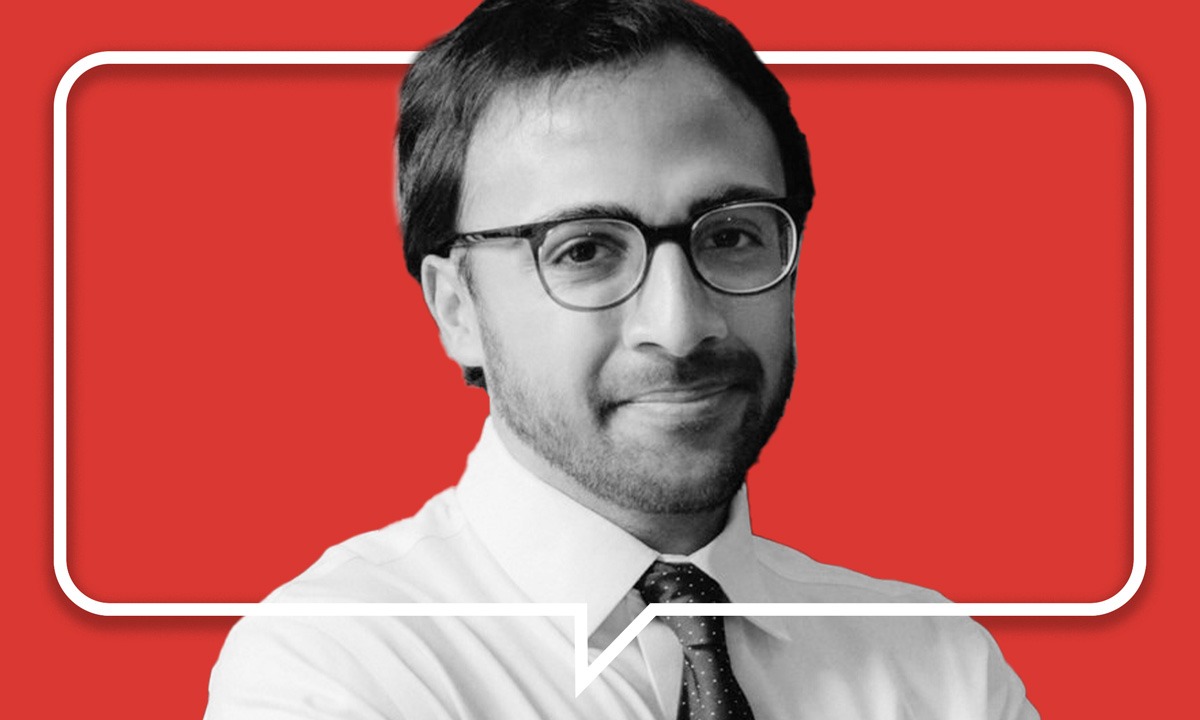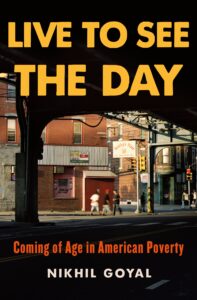74 Interview: Senate Advisor Nikhil Goyal Calls on Washington to Answer Child Poverty’s Call
With 5 million more children living in poverty nationwide as key funding expires, Goyal’s new book shows what's at stake for students and schools.

Get stories like this delivered straight to your inbox. Sign up for The 74 Newsletter
Growing up in Philadelphia’s poorest neighborhood, Corem Coreano had gotten used to apartments ravaged by mold and run by slumlords, including one who sold their home without notice.
But being awakened in the middle of the night by sharp pains was new for Coreano and their family. Rats had begun to bite them in their sleep. Later that morning, they went to their Kensington school and pretended nothing happened.
Chronicling the life of Corem and two other Puerto Rican students from Philadelphia, author Nikhil Goyal presents harrowing accounts of childhood in his latest book Live to See the Day: Coming of Age in American Poverty.

Readers see Corem, Ryan Rivera and Giancarlos Rodriguez grow up overpoliced and underfed. By the time they reached high school, the system threatened to close some 37 schools, and only after continued protests from Giancarlos and many other school community members, shuttered 24.
In some cases walking an hour one-way to school without transportation after an eviction left them displaced, Corem, Ryan and Giancarlos give low-income children a human face and serve as a cautionary tale. The Census Bureau has revealed the rate of childhood poverty has doubled, and the country will soon see pandemic-era relief for families, schools and childcare providers come to an end.
“If we believe that schools should be equitable and humane and child centered, then we’ve got to be willing to fight for an agenda that will end poverty,” said Goyal, who for the last two years served as the senior policy advisor for Senator Bernie Sanders on the Senate’s Health, Education, Labor, and Pensions and Budget Committees.
Their stories illuminate exactly how economic instability and harsh discipline policies impact children’s ability to learn safely, making the case for change, particularly as educators nationwide grapple with how best to support students academically after pandemic disruptions.
Making economic stimuluses like the Child Tax Credit permanent, Goyal added, would mean “the lives of educators and school staff and counselors would be a lot easier.”
Named one of 2023’s best books by the New Yorker, Live to See the Day also illuminates how school policies governing students can disproportionately shape entire futures, particularly for students of color who are more often suspended and expelled than their peers. Zero tolerance discipline policies, for instance, put children like Ryan Rivera in juvenile incarceration and harsh schooling isolated from friends for years, after being pushed to light a trashcan on fire at 12 years old.
In conversation with The 74, Goyal reflects on school closures, community schooling, chronic absenteeism, and what policies stand to make a difference for the nearly 9 million kids living in poverty nationwide.
This interview has been lightly edited for length and clarity.
You frame childhood poverty as a crisis to be urgently addressed — why release this book now? What’s happening?
The Census Bureau released its annual poverty report for 2022 — child poverty more than doubled. More than 5 million children are plunged into poverty. It was the single largest increase in poverty in recorded history, just an astonishing development in public policy that I think deserves enormous attention as well as a full-throated response from people in Washington and people in power.
The increase in child poverty coincides with the expiration of the expanded Child Tax Credit, economic stimulus payments, expanded unemployment insurance, and a number of other programs that have enormously benefited children and families, whether in terms of food assistance, or housing assistance, or Medicaid access.
We’re also at this moment where a lot of districts throughout the country are facing dropping enrollments, facing fiscal cliffs with the end of ESSER funds. People are anticipating a lot more consolidations, and possibly something like what happened in Philadelphia where a school system weighed closing dozens of schools. What are some lessons that school leaders might glean from what happened in Philadelphia?
In 2013, the school district proposed closing some three dozen. The argument was that the district was bleeding in a major fiscal deficit. In the book I cite a major report by Boston Consulting Group, commissioned by the district to evaluate the fiscal state of schools. One of the recommendations was a mass closure of schools. They also recommended a mass firing of teachers and other school staff and a very market-oriented approach to public education. The key recommendation was taken up by the school district, against the wishes of students and parents and educators and unions, who were an incredibly robust coalition.
Pew Research and others have found that school closures haven’t actually yielded the balance of savings that the architects originally envisioned. They cause a lot of displacement, educational instability. And, and in many instances, students are not actually necessarily attending so-called “higher performing schools” after their schools shut down.
I read about Fairhill School, this extraordinary school in the poorest neighborhood of Philadelphia, which had been serving generations upon generations of children of the working class. This was a school that had been deeply underfunded. And in spite of that, they were still able to provide children with a nurse, a safe environment.
Their test scores weren’t as good as suburban districts, sure. But does that mean that we should necessarily be closing a school like that which has been an anchor of the community? I don’t think so. I think if we provide public schools with equitable resources, and the type of respect that they deserve, so many of the issues that folks might point you to in public education, I don’t think would exist.
The charter movement has capitalized on this. But if you go back to the history of charter schools, and you go back to Minnesota and some of the earliest charter schools, these were laboratories of progressivism. We’re gonna bring innovation, bring the best, experiment with interesting ideas in pedagogy and curriculum and instruction and the teaching force. See what works and then bring the best ideas into the public system. That is the model that I would prefer, where charter schools work in tandem with public schools, not as competition.
Something I appreciated while reading is that you give these trends and the political events around them a human face, from the war on drugs and no tolerance policies for violence that led to thousands of incarcerated youth. What’s currently underway that you think might be on track to cause more devastation? Particularly for Black and brown children?
I think there’s a dramatic rise in the privatization movement. We’re seeing a dramatic increase in the voucher schemes as well as charter expansion. In Philadelphia alone, nearly 40% of children attend either charter schools or cyber charter schools. There’s cities all over this country where traditional public schools have become dismantled, and we’re seeing a rise of the private sector intervening in public education. There’s obviously some really amazing organizing and efforts by teachers unions and advocacy groups like Journey for Justice fighting back against those policies all over the country.
What’s at stake, if these models are to continue at the scale that they have? What would be the impact for students, based on your research and experience with Philadelphia?
If we continue down this path, where more and more charters replace traditional public schools, where voucher programs siphon even more dollars away from the public system into the private system, particularly the religious sector, then I think that’s one of the most grave and profound threats to American democracy. I think the foundations of American democracy are found in public education. I think it’s one of the areas of our society that has not been fully transformed and taken over by the market.
Look at health care, look at energy, look at housing. By and large, public education has withstood a number of those assaults over generations, but I think public schools are facing their most serious threats. The pandemic didn’t help. We can debate about school closures, the efficacy of that or not, but I think the reality is that they breed a distrust among parents who were rightfully frustrated about making sure that there was a place for their children to be during the day and be educated.
One exception to this threat you’ve identified to the traditional public system is the expansion of 3K and pre-K programs in many cities.
The early childhood education space is very fascinating to me. Public dollars might go to both public providers as well as private providers, and you’re seeing that there’s not a sustained level of federal dollars. A lot of those private providers cannot remain open because their margins are so low.
There is a growing interest from states all over this country as well as cities like Tulsa, Oklahoma, where they have poured an enormous amount of money into public pre-K. We’re talking about an area of great optimism. I am deeply encouraged by efforts by states and cities to expand early childhood education, because it is not only the right thing to do, it is good for our economy and society.
At one point in the book, you say their story is one of survival, where 18th birthdays are not rites of passage, but miracles. That it’s a story of social contract in tatters. In this reality, where so many children grow up in poverty, what are some best practices for school systems?
I think every school should be turned into a community school, where they have wraparound services, social and health supports. Universal free school meals, extended hours, restorative justice, well paid teachers and staff and modernized infrastructure.
There are incredible examples of community schools all over this country. I will point to Cincinnati as the gold standard for community schooling, because they’ve converted virtually all of their public schools into Community Learning Centers. I am always struck by the fact that they have dentists and mental health professionals and other medical staff and doctors who are literally based in the school itself to provide care to students.
We have to recognize that the issues and challenges that young people experience in their homes and in their communities don’t get left behind when they go to school every day. It affects their ability to learn. It affects their relationships with their teachers and counselors, and their relationships with their peers.
We’ve got to really recognize that poverty and economic insecurity is the root cause of many of these educational inequalities. That schools can be places where children can get access to healthcare and all their social support. I’m very encouraged by that trend across the country. And the research shows that community schools have a positive impact on absenteeism, on truancy, on graduation rates, and student engagement.
It’s the idea of, meet people where they’re at, provide them with the basic, basic building blocks for dignified life and you will see many of the social problems that once existed, either be reduced or eliminated.
A third of students were chronically absent by the end of the last school year, and we’re hearing more and more about school avoidance. What does Corem’s story reveal about this trend and its links with mental health, which is what some believe to be a root cause right now?
It’s a great crisis. I would say that Corem has a harrowing, fascinating story with a lot of lessons. Today Corem uses they/them pronouns. When they were growing up, they lived with their mother who was disabled. They endured consistent housing and food insecurity. They would run out of food. They had to endure evictions. They moved in some years, twice or three times, which meant that they had to constantly switch schools and never really settle into one school. That meant Corem’s academic performance faltered.
I know they’ve suffered from absenteeism at times, not due to their own failings, but simply because they were deprived of the basic necessities of a decent life. They didn’t have the tools and resources that would allow him to get to school on time every day. There’s one moment in the book where the landlord tells their mother that sorry, we just sold the house and you have to leave immediately.
That means, in the middle of the school year, they have to walk more than an hour from the new home to the old school. Their mother was able to get them a public transit pass, but it just goes to show homelessness and housing insecurity are huge obstacles to consistent and regular school attendance.
There’s a lot of research to show that homeless students in particular make up a significant part of the population that is going to be absent. As emergency rental assistance winds down and now we’re more than two years since the end of the national eviction moratorium, our families are really suffering through the housing affordability crisis. And I think we see that play out with children.
Get stories like these delivered straight to your inbox. Sign up for The 74 Newsletter

;)
